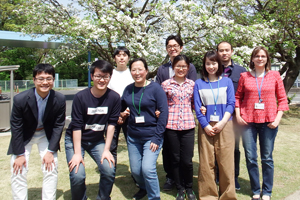Jun. 8, 2018 Research Highlight Chemistry
A nature-inspired electrocatalyst holds promise for denitrification
A catalyst with an unusual step-by-step mechanism could turn troublesome fertilizer runoff into harmless nitrogen gas
 Figure 1: A beach in Brittany, France, covered by sea lettuce. Many beaches in Brittany are regularly affected by huge algal blooms due to fertilizers, primarily nitrates, leaching from farms into rivers. The algae pose a health hazard due to the poisonous fumes produced as they decay. A catalyst created by RIKEN researchers could be used to convert excess nitrates into benign nitrogen gas and hence reduce the occurrence of such algal blooms. © PATRICE LATRON/LOOK AT SCIENCES/SCIENCE PHOTO LIBRARY
Figure 1: A beach in Brittany, France, covered by sea lettuce. Many beaches in Brittany are regularly affected by huge algal blooms due to fertilizers, primarily nitrates, leaching from farms into rivers. The algae pose a health hazard due to the poisonous fumes produced as they decay. A catalyst created by RIKEN researchers could be used to convert excess nitrates into benign nitrogen gas and hence reduce the occurrence of such algal blooms. © PATRICE LATRON/LOOK AT SCIENCES/SCIENCE PHOTO LIBRARY
A catalyst inspired by nature may help bring the global nitrogen cycle back into balance, research by RIKEN scientists suggests1. It promises to offer a way to remove excess nitrogen from wastewater, which is currently upsetting the nutrient balance of natural ecosystems.
Nitrogen comes in many forms in nature—from biologically inert molecular nitrogen (N2) in the air to ammonia and nitrates in soils and water, which plants depend on for growth. While various microbes in the soil convert nitrogen from one form to another, the industrial production of ammonia for fertilizer has overwhelmed nature’s ability to cycle ammonia, nitrates and nitrites back into nitrogen gas. Algal blooms are one symptom of excess nitrites and nitrates in marine ecosystems (Fig. 1).
To rebalance the nitrogen cycle, researchers have been developing catalysts that turn nitrates into nitrogen gas. But it has proven very challenging to funnel the nitrogen through the series of electron- and proton-transfer steps required for this transformation without generating undesired by-products.
Now, inspired by nature’s denitrification microbes, Ryuhei Nakamura of the RIKEN Center for Sustainable Resource Science and his team have developed an oxomolybdenum electrocatalyst with unusual reactivity that overcomes the selectivity problem.
Whereas proton and electron transfer occurs together for most denitrification catalysts, Nakamura’s team realized their catalyst operated stepwise, via sequential proton−electron transfer (SPET).
 Ryuhei Nakamura (fifth from the right) and his group have developed a catalyst inspired by nature that could help restore equilibrium to the global nitrogen cycle. © 2018 RIKEN
Ryuhei Nakamura (fifth from the right) and his group have developed a catalyst inspired by nature that could help restore equilibrium to the global nitrogen cycle. © 2018 RIKEN
The key observation was that the catalyst’s activity depended highly on the pH, which would be expected only if proton transfer was a separate step. “SPET function is very rare, and so it came as a big surprise that our oxomolybdenum catalysts showed catalytic activity that clearly depended on the pH,” says Nakamura.
The catalyst’s pH sensitivity meant that the researchers could adjust the pH to maximize the rate of N2 formation and minimize by-products. Using a technique called operando spectroscopy, they analyzed the pH dependence and verified that the catalyst operated via the SPET pathway.
The catalyst’s selectivity needs to be enhanced even further before it can be used for wastewater treatment, Nakamura says. “We will try to improve the selectivity of nitrogen gas generation by regulating temperature and so on,” he says. “In parallel, we will deepen our physicochemical understanding of SPET, as it has potential to broaden the horizon of catalytic chemistry,” he adds. For example, reaction selectivity issues have hampered efforts to convert emissions of carbon dioxide, the main agent of climate change, back into useful chemicals and fuels. SPET catalysis could allow researchers to selectively turn carbon dioxide into products desired by the chemical industry.
Related contents
References
- 1. He, D., Li, Y., Ooka, H., Go, Y. K., Jin, F., Kim, S. H. & Nakamura, R. Selective electrocatalytic reduction of nitrite to dinitrogen based on decoupled proton−electron transfer. Journal of the American Chemical Society 140, 2012−2015 (2018). doi: 10.1021/jacs.7b12774
